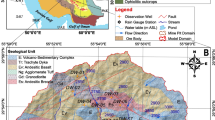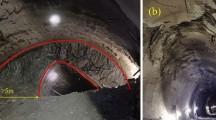Abstract
Groundwater has a negative impact not only in construction activity, but also in stability of a tunnel. Severity increases particularly in tunnels passing through fault gouge and breccia, where rock material is completely crushed and extremely weak. Instantaneous collapse and excessive plastic deformation is most likely in tunnels passing through such zones. Often, ‘flowing’ conditions may prevail if groundwater is mixed in the rock mass. This paper presents one such tunnel case in the Nepal Himalaya; i.e. the Modi pressure tunnel. This pressure tunnel passes through a tectonic fault consisting of gouge material. High deformation in the tunnel was observed while excavating the tunnel through the fault. Based on the tunnel deformation that was actually measured, the paper first back-calculates the rock mass strength by analytical approach. Then, the extent of in-situ stress condition in the area is determined by numerical modeling for the rock mass with no ground water in consideration. The ground water effect is then analyzed. We found that the effect of ground water with a static head <1.5 bar pressure may increase the deformation by up to a maximum of 30 %. Finally, we briefly discuss uncertainties related to the input parameter study and used methodologies.


















Similar content being viewed by others
References
Anagnostou G, Kovari K (2003) The stability of tunnels in grouted fault zones. Swiss Federal Institute of Technology, Zurich
Barbosa RE (2009) Analytical solution for deep tunnel excavated in a porous elasto-plastic material considering the effects of seepage forces. In: Proceedings of the 3rd CANUS rock mechanics symposium, Toronto
Barla G (2000) Analysis and design methods of tunnel in squeezing rock conditions. Riv Ital Di Geotec 1:1–22
Barton N, Line R, Lunde J (1974) Engineering classification of rock masses for the design of tunnel support. Rock Mech 6:189–236
Carranza-Torres C, Fairhurst C (2000) Application of the convergence-confinement method of tunnel design to rock masses that satisfy the Hoek–Brown failure criterion. Tunn Undergr Space Technol 15(2):187–213
Carranza-Torres C, Zhao J (2009) Analytical and numerical study of the effect of water pressure on the mechanical response of cylindrical lined tunnel in elastic and elasto-plastic porous media. Int J Rock Mech Min Sci 46:531–547
Grimstad E, Barton N (1993) Updating of the Q-system for NMT. Proceedings of the international symposium on sprayed concrete—modern use of wet mix sprayed concrete for underground support, Fagernes. Norwegian Concrete Association, Oslo
Himal Hydro and General Construction Ltd (2001) Construction report. Modi Khola Hydroelectric Project, Nepal
Hoek E (1999) Support for very weak rock associated with faults and shear zones. Distinguished lecture: international symposium on rock support and reinforcement practice in mining, Kalgoorlie, Australia
Hoek E, Brown ET (1997) Practical estimates of rock mass strength. Int J Rock Mech Min Sci 34(8):1165–1186
Hoek E, Marinos P (2000). Predicting tunnel squeezing problems in weak and heterogeneous rockmasses. Tunnels and tunnelling international, 32 (11), pp 45–51 and vol 32 (12), pp 34–46
Hoek E, Carranza-Torres C, Corkum B (2002) Hoek–Brown failure criterion, 2002 edition. In: Proceedings of the 5th North American rock mechanics symposium, Toronto, Canada, pp 267–273
Itasca Inc. (2004) FLAC3D User’s manual. Minneapolis, USA
Nepal KM (1999) A review of in-situ testing of rock mechanical parameters in hydropower projects of Nepal. J Nepal Geol Soc 19:1–8
Nilsen B, Palmstrøm A (2000) Engineering geology and rock engineering, handbook no. 2. Norwegian Group for Rock Mechanics (NBG), Norway
Panthi KK (2012) Evaluation of rock bursting phenomena in a tunnel in the Himalaya. Bull Eng Geol Environ 71:761–769
Panthi KK (2006) Analysis of engineering geological uncertainties analysis related to tunnelling in himalayan rock mass conditions. Doctoral Thesis at NTNU 2006:41, Department of Geology and Mineral Resources Engineering, Norwegian University of Science and Technology, Norway
Paudel TR, Dongol V, Sharma RH (1998) Construction phase engineering geological study in Modi Khola hydroelectric project, Nepal. J Nepal Geol Soc 18:343–355
Shin Y, Kim B, Shin J, Lee I (2010) The ground reaction curve of underwater tunnels considering seepage forces. Tunn Undergr Space Technol 25:315–324
Sunuwar S (2005) Problem of shear zones and faults in construction of infrastructures in the Nepal Himalaya. J Nepal Geol Soc 32
Upreti BN (1999) An overview of the stratigraphy and tectonic of the Nepal Himalaya. J Asian Earth Sci 17:577–606
Vlachopoulos N, Diederichs MS (2009) Improved longitudinal displacement profiles for convergence confinement analysis of deep tunnels. Rock Mech Rock Eng 42:131–146
Wise DU, Dunn DE, Engelder JT, Geiser PA, Hatcher RD, Kish SA, Odom AL, Schamel S (1984) Fault-related rocks: suggestions for terminology. Geology 12:391–394
Author information
Authors and Affiliations
Corresponding author
Rights and permissions
About this article
Cite this article
Shrestha, P.K., Panthi, K.K. Groundwater Effect on Faulted Rock Mass: An Evaluation of Modi Khola Pressure Tunnel in the Nepal Himalaya. Rock Mech Rock Eng 47, 1021–1035 (2014). https://doi.org/10.1007/s00603-013-0467-7
Received:
Accepted:
Published:
Issue Date:
DOI: https://doi.org/10.1007/s00603-013-0467-7




